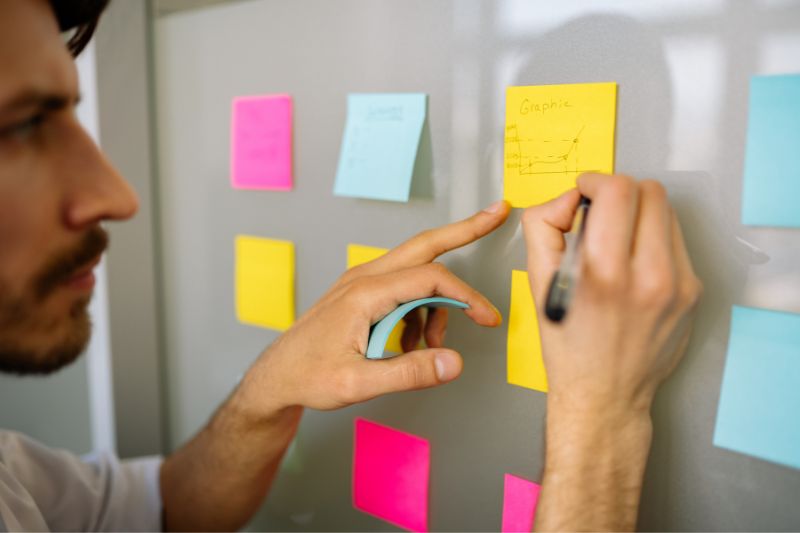Ask Dr. Saline: How Do I Motivate Myself to Get Started on Big Projects?
 Dear Dr. Saline,
Dear Dr. Saline,
I’m having a hard time getting big projects at work completed on time. I do ok with smaller projects that are concrete. But when I have a longer term project that isn’t so cut and dry, I just don’t know how to get organized and get started. My ADHD has made me a professional procrastinator. So I end up pulling all-nighters and handing in my work bleary-eyed the morning it’s due. I’m exhausted and I know it’s not my best effort. I want to do better and put an end to the stress, mediocrity and disappointment. What advice do you have for how to get started on big projects and stop procrastinating?
Thanks,
Brandon
From Dr. Saline:
Dear Brandon,
Many people with ADHD struggle with productivity due to a number of executive functioning skills that relate to motivation. Whether it’s initiation, planning, organizing, time management, sustained attention or focus, it’s common to struggle with knowing where to begin an ambiguous project and watch procrastination creep in faster than a rough sea during a hurricane.
Plus, living with a Now/Not now brain, lower amounts of dopamine and norepinephrine in the brain and inconsistent attention patterns all combine to create a massive overwhelm freeze and intense avoidance. So you, like so many other folks with ADHD, put unpleasant, unclear things off until the pressure of the deadline creates a crisis mode in your brain and body. Now buoyed by adrenaline and cortisol, you rush madly to complete something, get it done but wind up depleted and exhausted afterwards. It’s a frustrating and unhealthy cycle to live with.
Managing Ambiguity
 Let’s tackle this pattern by first looking at the impact of ambiguity on a task. Unstructured projects–whether they are for work or school–can paralyze people of all ages with ADHD. A lack of clarity about what you are supposed to do, how to proceed and where to begin can thwart the best of intentions. Plus, the ambiguity of a task makes organizing materials, planning for time and prioritizing what matters most seem impossible: it’s all just one big shapeless blob.
Let’s tackle this pattern by first looking at the impact of ambiguity on a task. Unstructured projects–whether they are for work or school–can paralyze people of all ages with ADHD. A lack of clarity about what you are supposed to do, how to proceed and where to begin can thwart the best of intentions. Plus, the ambiguity of a task makes organizing materials, planning for time and prioritizing what matters most seem impossible: it’s all just one big shapeless blob.
Improving motivation starts by finding a reason to do something and then clarifying what needs to get done by chopping the blob into smaller parts. Interest fosters motivation so what can possibly engage you in this task? It might not be the inherent pleasure in completing it and that’s fine. How can you link doing parts of this project to something that matters to you? How can you set up small, earned rewards along the way? What are the components of this task? Do a brain dump and, once you’ve looked at what’s entailed, put items that relate to each other together.
For example, if your task is to write up summaries of client contacts that day and then categorize them, start by grouping interactions by length of sessions (short vs. long), or times when they occurred during the day (morning or afternoon). This shortens a big, unwieldy project into something manageable.
Recently, I had to create two training sessions simultaneously: one was six hours and one was four hours. Yes, these were for my trip to Australia but that was a month away. I felt overwhelmed by these tasks. I decided to address one training at a time and start with the longer one–I needed to eat the frog, so to speak. Then I broke it down into four sections based on the breaks that the hosts had requested. Whew. I could more easily create four training sessions of one and half hours. I also like to work for 90 minute chunks before taking a break. I’d leave myself some Post-it pebbles to find my way back to what I was thinking before I stopped too.
I also found a colleague who wanted to do some Zoom co-working. These made the project seem doable. When one section was finished, I rewarded myself with a walk outside, a lunch or coffee break or talking on the phone to a supportive friend who was encouraging me. At the end of a day, instead of judging myself for what was left to do, I tried to appreciate what I had accomplished. Again, my friend and my Zoom buddy helped because we both shared. These strategies and incentives, along with the knowledge that I would feel much less anxious when the presentation was done, provided me with that key motivation I needed.
You too can improve your motivation by starting with finding some aspect of a project that interests you. Then, armed with your reason for engagement, create helpful incentives, adjust the size of the task, pay attention to your capacity and time for focus, identify individual challenges, and emphasize progress. Put the have-to’s before the want-to’s and ask a friend or colleague to be a Zoom buddy, body double or accountability partner. By increasing motivation and decreasing ambiguity, even a little bit, you are more likely to get moving on the task at hand.
Tips for Increasing Productivity
The following are more specific tips for ADHD adults who are looking to increase productivity.
Reframe your view of the task
 The greatest barrier to initiation is your perception of the task. You may understand the need of doing something but lack the interest, skill or focus to do it. Make tasks small enough that beginning them is within your reach. For example, instead of worrying about the entire research project, make it a goal to just work on the intro or hypothesis. Consider how long you can concentrate and for how long: then create work periods based on that information. Build in short and longer breaks, using timers and notes to get you back to what you were doing.
The greatest barrier to initiation is your perception of the task. You may understand the need of doing something but lack the interest, skill or focus to do it. Make tasks small enough that beginning them is within your reach. For example, instead of worrying about the entire research project, make it a goal to just work on the intro or hypothesis. Consider how long you can concentrate and for how long: then create work periods based on that information. Build in short and longer breaks, using timers and notes to get you back to what you were doing.
Chunk it and chunk it again
 The size of the task affects initiation, a critical element of motivation. If a task seems insurmountable, it’s much more difficult to start it. This is especially true for neurodivergent thinkers. So, break things down into chunks and start small. If you still can’t begin, then the task is still too big. Make it smaller. Keep a list of three tasks on a list, either on paper or digitally, and cross each one out as you complete it. There’s so much satisfaction in knowing you’re making progress. Not surprisingly, this will also give you more motivation to keep going until the entire project is completed. You are looking for small wins to build confidence and energy so you can keep going.
The size of the task affects initiation, a critical element of motivation. If a task seems insurmountable, it’s much more difficult to start it. This is especially true for neurodivergent thinkers. So, break things down into chunks and start small. If you still can’t begin, then the task is still too big. Make it smaller. Keep a list of three tasks on a list, either on paper or digitally, and cross each one out as you complete it. There’s so much satisfaction in knowing you’re making progress. Not surprisingly, this will also give you more motivation to keep going until the entire project is completed. You are looking for small wins to build confidence and energy so you can keep going.
Track Your Focus
 In addition to initiation, focus is another important element of motivation. People with ADHD and chronic difficulties with inattention have some areas where they can pay attention with no problem. They lack attention for uninteresting tasks.
In addition to initiation, focus is another important element of motivation. People with ADHD and chronic difficulties with inattention have some areas where they can pay attention with no problem. They lack attention for uninteresting tasks.
Focus is a dynamic process of what is critical to notice or do. It is the spotlight of your attention. You can improve focus by noticing where it is and where it’s not. If you have a tendency to drift off while working or studying, create a plan for recovering focus when you catch your attention shifting away from the task at hand. It’s often helpful to create a work space for yourself which lacks distractions, like a quiet room without a TV or other digital temptations. Make it a habit to leave your phone and other devices out of arm’s reach to give yourself the best chance to stay focused on your work.
Make Note of What’s Working
 Self-evaluation, also known as metacognitive awareness, is the last executive functioning skill to coalesce, in the mid to late twenties for people with ADHD. Self-evaluation refers to the abilities for self-understanding, judgment and decision-making. Better self-awareness fosters academic and social competence.
Self-evaluation, also known as metacognitive awareness, is the last executive functioning skill to coalesce, in the mid to late twenties for people with ADHD. Self-evaluation refers to the abilities for self-understanding, judgment and decision-making. Better self-awareness fosters academic and social competence.
As an exercise, think of what has worked well for you previously, and what didn’t when faced with a similar project. What lessons can you apply from those prior experiences to what’s in front of you right now? Create a strategy around doing more of what’s working well for you.
It may take some trial and error to come up with an approach which works well for you. That’s ok, it’s all part of learning and maturing. Stay positive, curious, and open-minded. Now let’s roll up our sleeves and get to work!
